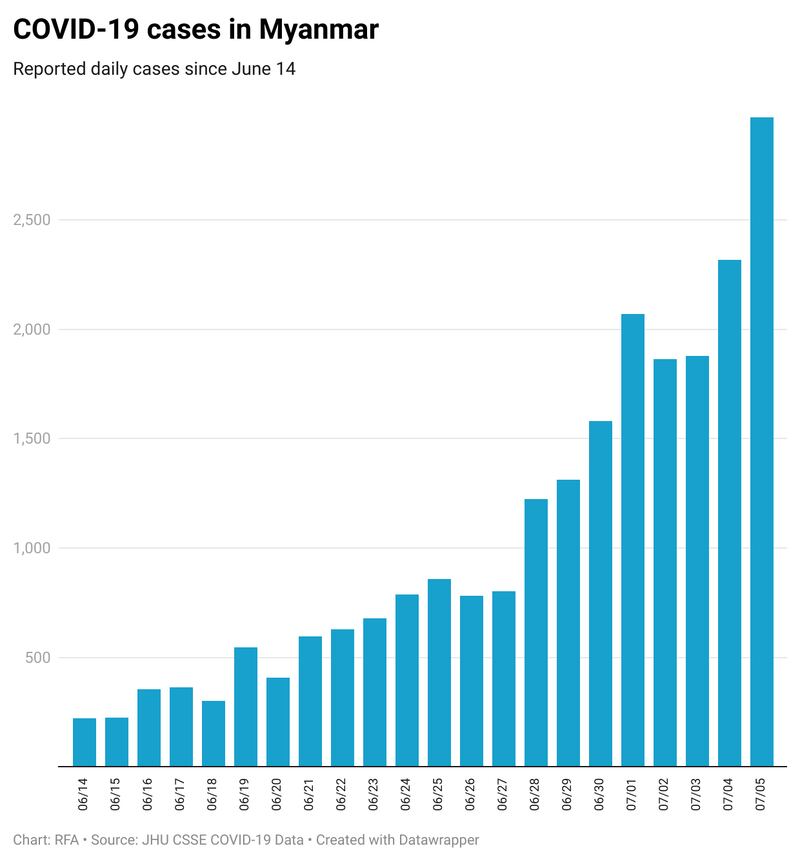Nearly 500 people in northwest Myanmar’s strife-torn Kalay township are believed to have died of COVID-19 over the past 30 days, as the country struggles with a third wave of the coronavirus.
Myanmar’s efforts to contain the coronavirus were dealt a substantial blow on Feb. 1, when the military orchestrated a coup d’état, claiming that a landslide victory by Aung San Suu Kyi’s National League for Democracy (NLD) in the country’s November 2020 elections was the result of widespread voter fraud—launching the country into chaos.
The junta has yet to provide evidence for its claims and has violently suppressed mass demonstrations against the takeover, killing at least 894 people and arresting more than 5,000, according to the Assistance Association for Political Prisoners (AAPP), a Thailand-based rights group.
Tens of thousands of people have walked off the job to join the Civil Disobedience Movement (CDM) in opposition to the military, bringing services such as health care to a near standstill. In Myanmar’s remote border regions, where residents have formed People’s Defense Force (PDF) militias and engaged in fierce fighting with government troops, access to medical services is even more curtailed.
According to the latest statement from the junta’s Ministry of Health and Sports, more than 160,000 have been infected with COVID-19 and more than 3,400 have died since March 2020, when the virus was first reported in Myanmar.
Aid workers and local residents told RFA’s Myanmar Service that they now estimate the death toll over the past 30 days in the Sagaing region’s Kalay township—a population center of around 400,000 people that has been the scene of some of the worst fighting between the military and the PDF in recent months—has surpassed 500.
A Kalay resident told RFA that among the dead are 270 members of the ethnic Chin minority and 100 Bamars, or members of the country’s ethnic majority. In the first five days of July, 136 people have died, the resident said.
Between June 1 and July 6, Kalay’s cemeteries have been overflowing since about 500 bodies were brought in from the countryside.
Though it is not confirmed that all of the deaths were caused by COVID-19, the causes of death are in most cases symptoms of COVID-19, including fever, nausea and vomiting, according to local aid groups and Many family members of the dead have tested positive for COVID-19.
On Tuesday, a crematorium in Kalay was overwhelmed when 14 bodies arrived before noon.
“There are more than 10 bodies here and the crematorium can’t cope with the situation. Six bodies have so far been cremated and there are eight more left. The death toll has risen and so far, there were 14 bodies today,” Kyaw Htay, a Kalay resident told RFA.
“More might come in the evening. Those who died at home and those who died at the hospital, plus those who died in nearby villages, all end up here,” Kyaw Htay said.
According to estimates, the average COVID-19 death toll has risen to between 20 and 30 a day in Kalay since the last week of June.
“To be frank, the situation is very bad. There is no cure for this disease. COVID centers don’t have enough health workers or volunteers,” an elderly Kalay resident told RFA.
“There isn’t enough oxygen, so we have to find it ourselves. There were vaccinations given sporadically but a lot of people are just taking home remedies,” the man said.
Residents had been able to order oxygen from Myanmar’s two largest cities, Yangon and Mandalay, but this is now no longer possible, he said.
A week ago, the cost of a 15-liter cylinder of oxygen has risen from 130,000 kyat (U.S. $1 = 1646 kyat) a week ago to about 180,000, and that of a 40-liter cylinder has risen from 250,000 to 350,000.

To address the need for more oxygen, donations from various sources will go toward setting up a small plant in Kalay, capable of producing 70 40-liter tanks of oxygen each day and it is expected to be operational by the end of the week.
But residents told RFA that this will be nowhere near enough, when patients with severe symptoms need six to 12 tanks per day, and the town needs about 1,000 each day for all its patients.
“Oxygen is so hard to find, and it is now scarcer than gold here,” a resident who declined to be named told RFA.
“As soon as families of patients get up in the morning, they have to go around the city looking for oxygen tanks distributed by charity groups. It’s been going on like that for several weeks now,” the resident said.
Beyond the lack of oxygen supplies, the lack of health workers is another major difficulty Kalay has to navigate through this health crisis.
RFA contacted Win Cho Cho Aung, the deputy director of the Kalay District Public Health Department, who said he was not authorized to discuss the situation in Kalay.
“I’m not the district Health Chief. He’s now at the hospital and he himself is on sick leave. You cannot contact him," he said
In neighboring Chin state’s Tunzang and Falam townships, 57 people died of COVID-19 symptoms over the past month. Tunzang has a confirmed caseload of 613 people with 21 deaths, while Falam’s caseload was 359 with 36 deaths
Myanmar’s third wave of COVID-19 crossed over from India, which shares a border with the Sagaing region, in early May, when it arrived in Tunzang, spreading to other townships and villages from there.
According to data from Johns Hopkins University, Myanmar was reporting fewer than 500 new COVID 19 cases per day until June 19. It surpassed 1,000 cases per day just ten days later, then breached 2,000 per day on July 1. On July 5, the country reported almost 3,000 new cases.
Reported by RFA’s Myanmar Service. Translated by Khin Maung Nyane. Written in English by Eugene Whong.
